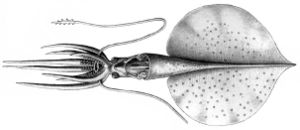Magnapinna
| Magnapinna | ||||||||||||
|---|---|---|---|---|---|---|---|---|---|---|---|---|

Magnapinna talismani |
||||||||||||
| Systematics | ||||||||||||
|
||||||||||||
| Scientific name of the family | ||||||||||||
| Magnapinnidae | ||||||||||||
| M. Vecchione & RE Young , 1998 | ||||||||||||
| Scientific name of the genus | ||||||||||||
| Magnapinna | ||||||||||||
| M. Vecchione & RE Young , 1998 |
The Magnapinnidae family with the only genus Magnapinna within the order of the squid contains rare species with a very special morphology . Until recently, only larvae were known, larva-like specimens and young animals, which were used to scientifically describe the family. However, some authors believe that a fully grown specimen has been found. Various video recordings show an animal with very similar morphology that has been nicknamed "long-arm squid" or "big-fin squid". However, no adult specimen has yet been caught, so it remains unclear whether the filmed cephalopod is actually such a specimen of this genus.
history
The first specimen from this genus was Magnapinna talismani and was caught in the Azores in 1907 . However, it was in poor condition and so little information could be extracted from the catch, so that the species was initially assigned to the Mastigoteuthidae family as Mastigoteuthis talismani . In 1956 a similar species ( Magnapinna sp. C ) was caught in the South Atlantic, but not investigated further. During the 1990s, two more specimens ( Magnapinna sp. A and Magnapinna sp. B ) were found in the Atlantic and three in the Pacific ( Magnapinna pacifica ). Scientists Michael Vecchione and Richard Young led the investigation and made the connection with the earlier finds. The unusually large fins, which reach up to 90% of the length of the mantle, were of particular interest and led to the nickname "large-fin squid". Due to the small number of specimens caught, the relationship between the individual species is still unclear; one possible, if unlikely, thesis is that they all belong to the same species.
Video recordings

The first video recording of a "long-arm squid" was made off the Brazilian coast in 1988 . There were at least four other recordings after that, but they received no media attention. It wasn't until a video of the Tiburon underwater robot attracted attention.
The specimens recorded in the recordings differed drastically from the previously known species. In contrast to all other squids, all arms were the same length and looked the same, very similar to those of the extinct belemnites . The animals also held them vertically away from their bodies, giving the impression that they were elbows . Most notable, however, was the length of the elastic tentacles: They were estimated to be 15 to 20 times the length of the mantle. In addition, their fins are enormous.
species
|
swell
- ↑ California Academy of Sciences: Science Now - New Creature from the Deep ( Memento of the original from March 29, 2007 in the Internet Archive ) Info: The archive link was inserted automatically and has not yet been checked. Please check the original and archive link according to the instructions and then remove this notice. (engl.)
- Shuker, KP N . 1998. A supplement to Dr. Bernard Heuvelmans' checklist of cryptozoological animals. Fortean Studies 5 : 208-229
- Vecchione, M., RE Young, A. Guerra, DJ Lindsay, DA Clague, JM Bernhard, WW Sager, AF Gonzalez, FJ Rocha & M. Segonzac. 2001. Worldwide observations of remarkable deep-sea squids. Science 294 : 2505-2506.
- Specimen copy of a Magnapinna talimani (juv.) Exhibited in the Zoological Museum in Kiel since May 2012.
Web links
- Tree of Life web project: bigfin squid (Engl.)
- Video recordings (Engl.)